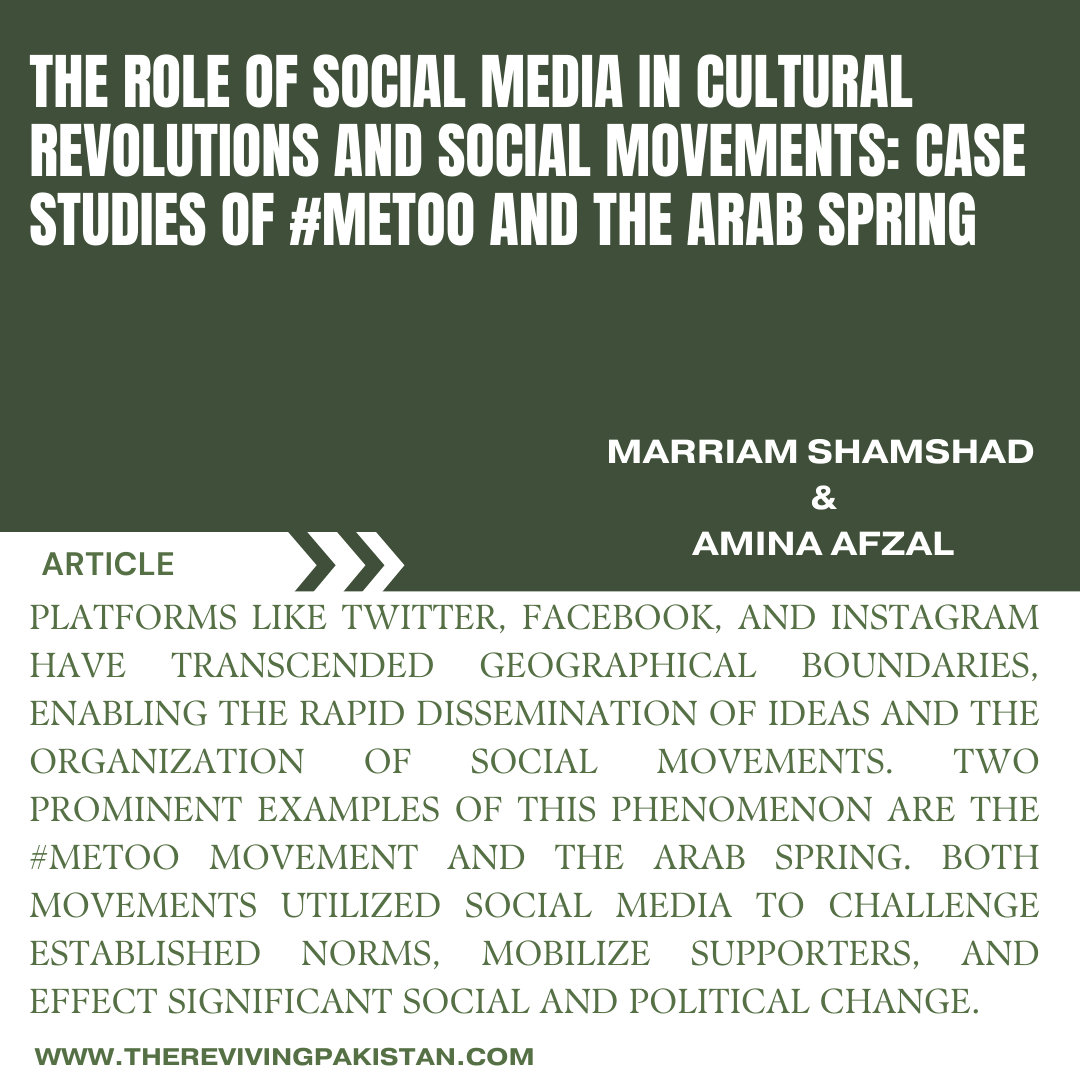About the Author(s)
Marriam Shamshad and Amina Afzal are currently pursuing their Bachelor’s degrees in Physics at Fatima Jinnah Women University. They are passionate about exploring the intersection of social media and social movements, particularly interested in how digital platforms contribute to cultural revolutions. While their academic background is rooted in physics, their interdisciplinary interests have led them to investigate the impact of social media on cultural revolutions and social movements.
In the digital age, social media has emerged as a powerful tool in shaping public discourse and mobilizing collective action. Platforms like Twitter, Facebook, and Instagram have transcended geographical boundaries, enabling the rapid dissemination of ideas and the organization of social movements. Two prominent examples of this phenomenon are the #MeToo movement and the Arab Spring. Both movements utilized social media to challenge established norms, mobilize supporters, and effect significant social and political change. This article explores how social media was pivotal in these cultural revolutions and social movements.
The Arab Spring: A Digital Uprising
The Arab Spring began in December 2010 and was a series of anti-government protests and uprisings across the Arab world. The movement started in Tunisia with the self-immolation of Mohamed Bouazizi, an act of protest against police corruption and economic hardship. This tragic event catalyzed a wave of demonstrations that quickly spread to other countries, including Egypt, Libya, Syria, and Yemen.
Social media played a crucial role in the Arab Spring, serving as both a communication tool and a platform for mobilization. Twitter and Facebook became the primary means for activists to organize protests, share information, and garner international support. The hashtag #Jan25, referring to the date of the Egyptian protests, trended worldwide, drawing global attention to the struggle for democracy and human rights in the region.
One of social media’s most significant contributions to the Arab Spring was its ability to bypass traditional media censorship. In many affected countries, state-controlled media were often complicit in suppressing dissenting voices and controlling the narrative. Social media platforms allowed activists to circumvent these restrictions, broadcast real-time updates, and expose government abuses. The viral spread of images and videos documenting the brutality of security forces helped to rally international condemnation and support for the protesters.
Moreover, social media facilitated the coordination of protests and the mobilization of diverse groups within society. In Egypt, for example, Facebook groups and Twitter hashtags were used to organize demonstrations and communicate logistical details. This level of organization was crucial in sustaining momentum and ensuring that the movement remained locally and globally visible.
The #MeToo Movement: Amplifying Voices and Challenging Power.
The #MeToo movement, which gained prominence in October 2017, highlights the power of social media in addressing issues of sexual harassment and assault. Originating as a social media hashtag, #MeToo became a global phenomenon as individuals from various backgrounds shared their experiences of sexual violence and harassment.
The movement’s inception can be traced back to activist Tarana Burke, who coined the phrase “Me Too” in 2006 to support survivors of sexual violence, particularly women of colour. However, it was not until the hashtag gained traction on Twitter that it became a widespread social movement. The hashtag was popularized by actress Alyssa Milano, who encouraged women to share their stories using #MeToo to demonstrate the pervasive nature of sexual harassment.
Social media played a transformative role in the #MeToo movement by providing a platform for survivors to voice their experiences and seek solidarity. The sheer volume of shared stories exposed the extent of the problem and challenged the pervasive culture of silence and complicity surrounding sexual harassment. The hashtag’s viral nature allowed for a broad range of voices to be heard, including those from marginalized communities who had previously been silenced.
The #MeToo movement also utilized social media to hold influential individuals accountable. High-profile figures in politics, entertainment, and business faced public scrutiny as allegations of misconduct emerged on platforms like Twitter and Facebook. The movement not only encouraged the reporting of harassment but also facilitated collective action, such as calling for resignations and implementing policy changes within institutions.
Social media also amplified the voices of activists and organizations working to address sexual harassment. Platforms’ widespread reach allowed for the dissemination of information about support resources, advocacy efforts, and legislative changes. Campaigns and online petitions gained traction, contributing to a broader societal shift towards recognizing and addressing issues of sexual violence.
Comparative Analysis: Social Media’s Impact
Both the Arab Spring and the #MeToo movement illustrate the transformative impact of social media on cultural revolutions and social movements. In the case of the Arab Spring, social media facilitated grassroots organizations, bypassed censorship, and garnered international support. The ability to rapidly share information and mobilize supporters was crucial in challenging authoritarian regimes and advocating for democratic reforms.
Similarly, the #MeToo movement leveraged social media to challenge entrenched power structures and give voice to marginalized individuals. The hashtag’s viral spread and the widespread sharing of personal stories played a crucial role in breaking the silence around sexual harassment and advocating for systemic change.
However, there are differences in how social media was utilized in these movements. The Arab Spring relied heavily on coordinating and organising physical protests, whereas the #MeToo movement primarily functioned through online platforms and virtual solidarity. The former focused on political and social change through direct action, while the latter emphasized raising awareness and challenging cultural norms.
Conclusion.
Social media has undeniably transformed the landscape of cultural revolutions and social movements. The Arab Spring and the #MeToo movement are compelling examples of how digital platforms can amplify voices, organize collective action, and challenge existing power structures. As social media continues to evolve, its role in shaping public discourse and driving social change will likely remain significant. The experiences of these movements highlight both the potential and limitations of social media in advancing social justice and cultural transformation.

